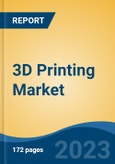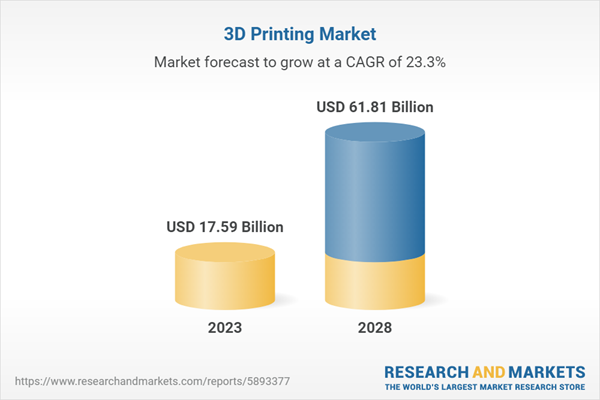Free Webex Call
The Global 3D Printing Market is expected to thrive during the forecast period 2024-2028F, the market is expected, due to the aggressive research and development of 3D printing and the rising demand for prototyping applications from a variety of industry sectors, particularly healthcare, automotive, and aerospace and defense. Speak directly to the analyst to clarify any post sales queries you may have.
10% Free customizationThis report comes with 10% free customization, enabling you to add data that meets your specific business needs.
A manufacturing method for creating three-dimensional items from digital files is known as three-dimensional printing. Through additive processes of sequential layers of material, 3D printing creates objects with the high precision and resource efficiency. In addition, 3D printing solutions like resin 3D printers, filament 3D printers, and services 3D printers have become increasingly popular in a variety of industries for the production of bespoke items. Previously, quick prototypes were the only use for 3D printing.
Growing application 3D printing technology
Industrial manufacturing is progressively utilizing 3D printing technology, particularly in the automotive, aerospace, and defense sectors. Tooling, jigs and fixtures, injection molding, and production part manufacturing could all benefit from 3D printing. 3D printing innovation is in a beginning phase of improvement across a few areas, like printed hardware, materials, footwear, and food and culinary; However, the jewelry, education, and art and architecture industries are rapidly adopting it. Printers and printing technologies have advanced, printing materials have improved, and a skilled workforce has emerged in the market. 3D printing tracks down expected chances to dispose of PCBs and produce listening devices, primary gadgets, print sensors, phone radio wires, batteries, sun-oriented cells, light-transmitting diodes, and other dynamic and latent gadgets.Substantial Investments of Governments and Tech Giants to Foster Market Growth
Digital interruptions are extremely affecting advanced manufacturing technologies in many nations worldwide. The United States could make use of 3D technology. This technology was included in the budget of the United States Department of Défense in 2018 as a crucial capability. Products aimed at additive and 3D printing manufacturing have been leaped by even tech software giants like Autodesk, Microsoft, and HP.In a similar manner, China is putting in a lot of effort to keep the manufacturing industry's competitive index in the global market. Because Chinese manufacturers perceive this technology as both a risk and an opportunity to boost the economy, they frequently make investments in its research and development. And same in India sees this technology as a chance to contribute more to the global manufacturing competitiveness. The Make in India Initiative and other active government programs support India's market. For instance, India Cements and the construction 3D printing startup Tvasta collaborated in May 2022 to promote sustainability in the construction industry.
Korea provides national support for the implementation of an independent roadmap for this technology's research and development. To encourage the use of this technology, the Korean government is accelerating industry regulatory agreements and implementing tax incentives. An independent 3D technology strategy has been developed by the British government; However, because of Brexit, the manufacturing sector in the United Kingdom is experiencing some uncertainty. Due to its well-established Industry 4.0 infrastructure, Germany is expected to define new technology strategies. Due to all these technologies development the market for the 3D printing will grow in the forecast period.
Advancement in 3D Hardware and Software is Generating New Revenue Streams for Market Players
New technologies are being upgraded and developed by established market players and tech-savvy start-ups. 3D printers for production have become faster and more dependable because of hardware advancements. One of the most widely used 3D printers is the polymer printer. In December 2022, Redington Limited signed a contract with ETEC, Materialize, and Wipro products to provide businesses with full-stack services and products to make the 3D manufacturing process easier. In addition, Redington Limited worked with Wipro 3D to make the introduction of polymer 3D printers in India easier.According to the statistics, new market opportunities for market participants would result from advancements in polymer additive manufacturing. Due to their capacity for high productivity and volume production, powder bed fusion technologies like HP Inc.'s Multi Jet Fusion and Fused Filament Fabrication (FFF) are anticipated to be the most popular industrial 3D technologies. In a similar vein, the dental and consumer goods industries are more likely to have a growing demand for resin-based technologies like Stereolithography (SLA) and digital light processing (DLP).
In a similar vein, the need to streamline operations is propelling software development in the 3D industry to new heights. Since the technology is used a lot in the manufacturing process, software that can help manufacturers increase production volumes and improve their additive manufacturing processes more effectively is in high demand.
Global Government investment in 3D printing projects will drive the market in forecast period.
To further investigate the opportunities presented by 3D printing technology and encourage its development, governments around the world are launching initiatives and providing funding to educational institutions, research centers, and technology organizations. National programs have been implemented in the United States, the United Kingdom, and Canada to encourage university-level 3D printing research, technological advancement, and startup development. Industries and governments around the world have turned to 3D printing because of the emergence of new uses for the technology. For instance, the UK National Strategy for Additive Manufacturing 2018-2025 aims to create 60,000 sector-specific jobs and generate 3844.59 million USD in annual gross value added (GVA) by 2025. The strategy depicts all the recommendations made by the workgroups that oversaw themes.
Market Segmentation
Global 3D Printing Market is segmented based on Component, Printer Type, Technology, Process, Vertical, regional distribution and competitive landscape. Based on Component, the market is divided into Hardware, Software and Services. Further, the Software sub-Segment is fragmented into Design Software, Inspection Software, Printer Software, and Scanning Software. Based on Printer Type, the market is segmented into Desktop 3D Printer and Industrial Printer. Based on Technology, the market is divided into Stereolithography, Fuse Deposition Modeling, Selective Laser Sintering, Electron Beam Melting, Laminated Object Manufacturing, and Others. Based on Process, the market is divided into Powder Bed Fusion, Vat Polymerization/ Liquid Based, Material Extrusion, Binder Jetting, Material Jetting, and Others. Based on Vertical, the market is divided into Automobile, Consumer Electronics, Medical, Aerospace & Defense, Education, and Others. Based on region, the market is further bifurcated into North America, Asia-Pacific, Europe, South America, Middle East & Africa.Market player
Major market players in the Global 3D Printing Market are Stratasys Ltd, 3D Systems Corporation, EOS GmbH, General Electric Company (GE Additive), Sisma SPA, ExOne Co., SLM Solutions Group AG, Proto Labs Inc., Hewlett Packard Inc., Nano Dimernsion Ltd.Report Scope:
In this report, the Global 3D Printing Market has been segmented into the following categories, in addition to the industry trends which have also been detailed below:3D Printing Market, By Component:
- Hardware
- Software
- Design Software
- Inspection Software
- Printer Software
- Scanning Software
- Services
3D Printing Market, By Printer Type:
- Desktop 3D Printer
- Industrial Printer
3D Printing Market, By Technology:
- Stereolithography
- Fuse Deposition Modeling
- Selective Laser Sintering
- Electron Beam Melting
- Laminated Object Manufacturing
- Others
3D Printing Market, Process:
- Powder Bed Fusion
- Vat Polymerization/ Liquid Based
- Material Extrusion
- Binder Jetting
- Material Jetting
- Others
3D Printing Market, Vertical:
- Automobile
- Consumer Electronics
- Medical
- Aerospace & Defense
- Education
- Others
3D Printing Market, By Region:
- North America
- United States
- Canada
- Mexico
- Asia-Pacific
- China
- India
- Japan
- South Korea
- Australia
- Europe
- Germany
- United Kingdom
- France
- Spain
- Italy
- South America
- Brazil
- Argentina
- Colombia
- Middle East
- Saudi Arabia
- South Africa
- UAE
Competitive Landscape
Company Profiles: Detailed analysis of the major companies present in the Global 3D Printing Market.Available Customizations:
With the given market data, the publisher offers customizations according to a company's specific needs.This product will be delivered within 1-3 business days.
Table of Contents
1. Product Overview
2. Research Methodology
5. Global 3D Printing Market Outlook
6. North America 3D Printing Market Outlook
7. Asia-Pacific 3D Printing Market Outlook
8. Europe 3D Printing Market Outlook
9. South America 3D Printing Market Outlook
10. Middle East & Africa 3D Printing Market Outlook
11. Market Dynamics
13. Company Profiles
Companies Mentioned (Partial List)
A selection of companies mentioned in this report includes, but is not limited to:
- Stratasys Ltd
- 3D Systems Corporation
- EOS GmbH
- General Electric Company (GE Additive)
- Sisma SPA
- ExOne Co.
- SLM Solutions Group AG
- Proto Labs Inc.
- Hewlett Packard Inc.
- Nano Dimernsion Ltd
Table Information
| Report Attribute | Details |
|---|---|
| No. of Pages | 172 |
| Published | October 2023 |
| Forecast Period | 2023 - 2028 |
| Estimated Market Value ( USD | $ 17.59 Billion |
| Forecasted Market Value ( USD | $ 61.81 Billion |
| Compound Annual Growth Rate | 23.3% |
| Regions Covered | Global |









